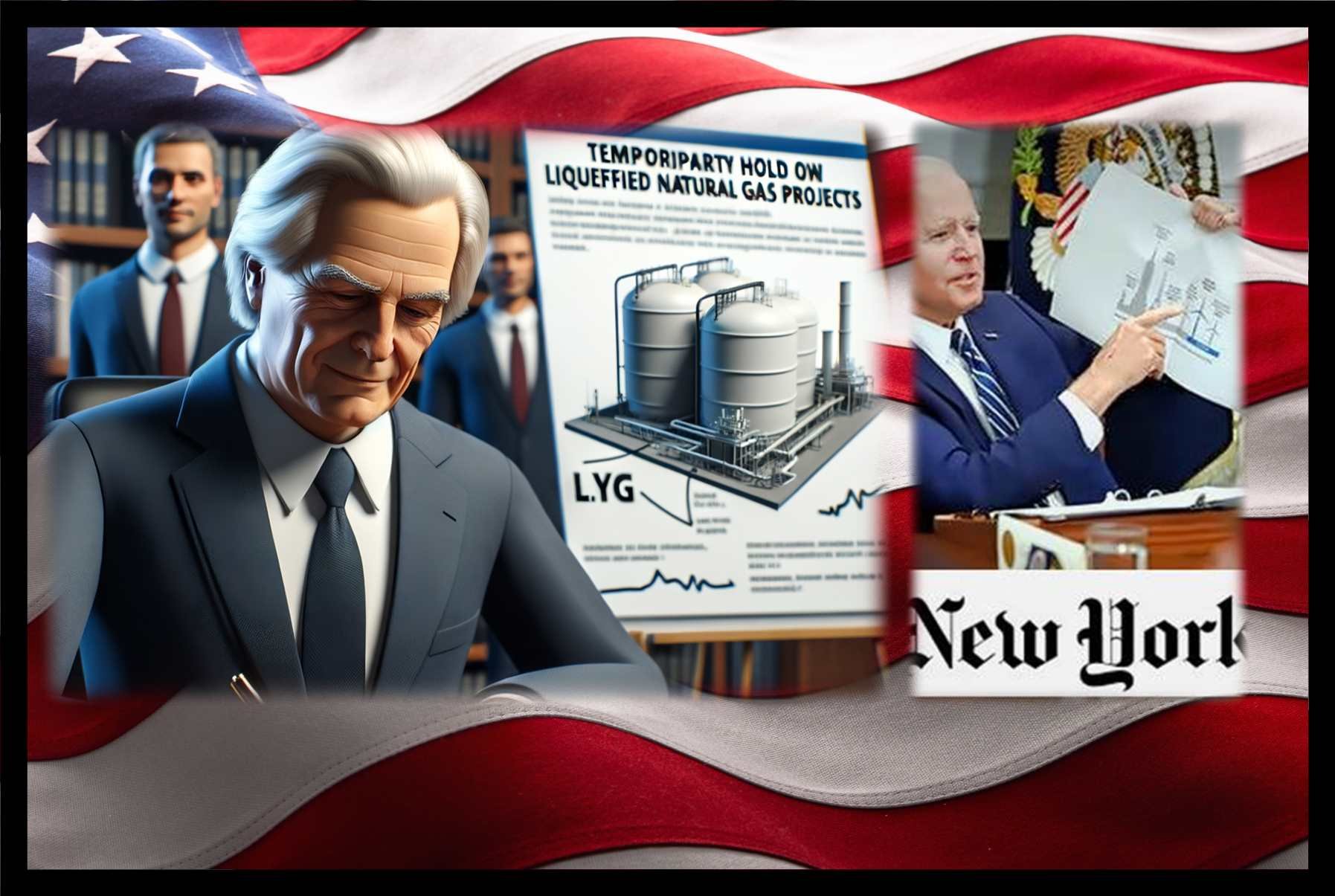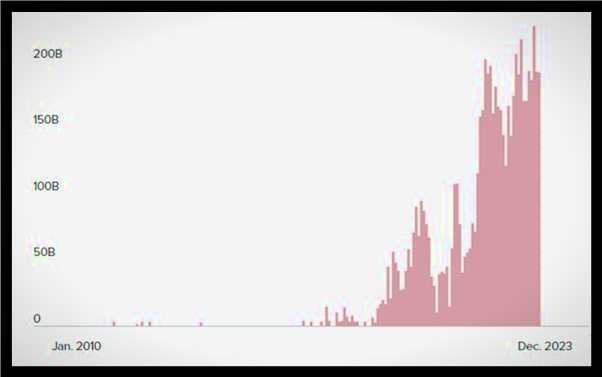Historically, relying on a single strategic fuel supplier has been a double-edged sword.
Europe’s new energy risk: Trading Russia for America
The EU replaced Russian energy with U.S. supplies after Moscow launched a war. Now people are wondering: Is Europe too dependent on America?
POLITICO BY GABRIEL GAVIN, PUBLISHED ON MARCH 3, 2024.
“As for all hypothetical scenarios, we will not be speculating on U.S. potential cuts in production or supply to the EU,” a senior EU official told POLITICO, granted anonymity to discuss the situation.
“EU and U.S. officials met in Washington last month for talks as part of the EU-US Energy Council, but the issue of LNG permits wasn’t on the official agenda or a broader list of topics shared with POLITICO ahead of the tête-à-tête.
“Then there’s the Donald Trump factor. If Trump returns to the White House he is almost certain to push for a massive fossil fuel expansion while riding roughshod over conventional climate science.
“While an American LNG production boom would likely drive down prices, particularly for the short-term contracts the EU favors, it would raise uncomfortable questions about whether European nations are enabling an anti-environmental crusade. It would also raise the specter that the continent had taken control of its energy markets away from Russian President Vladimir Putin and given it to President Trump.
Dear friends:
HAPPY SABBAT! AS WE PART WAYS WITH A PLEDGE TO REUNITE IN AUGUST, ECHOING GABRIEL GARCÍA MÁRQUEZ'S ENIGMATIC POSTHUMOUS LITERATURE, LET US WELCOME THE AMBIGUITY OF OUR CONFLICT-RIDDEN WORLD. TODAY, THE BRITISH NEWSPAPER "DAILY EXPRESS" DISCUSSES HOW AUTHORITIES ARE ADOPTING SCANDINAVIA'S MEASURES IN PREPARATION FOR A POTENTIAL GLOBAL CONFLICT. ON THIS SPECIAL DAY, MAY IT BRING YOU JOY, OPPORTUNITIES FOR SELF-REFLECTION, AND A SENSE OF POSITIVE ENERGY. WHETHER SPENT IN TRANQUIL SOLITUDE OR IN THE COMPANY OF LOVED ONES, MAY THE TIME BE ABUNDANT WITH LOVE AND BLESSINGS.
For the esteemed “Le Monde Diplomatique,” the world of the month of April is viewed in this manner:
“…CONFLICTS THROUGH THE LENS OF HISTORY: INDIA ELECTION SPECIAL, NEW DELHI IS NOT BEIJING; HAS INDIA BECOME THE WORLD’S FACTORY? NARENDRA MODI’S INDIA OILED BY CRONY CAPITALISM; IS INDIA NOW A DEMOCRACY IN NAME ONLY? AGRICULTURE ONCE MORE IN CRISIS; UKRAINE, MACRON’S POODLES THE NEW DOGS OF WAR; MOSCOW WANTS NO LESS THAN SURRENDER; ISRAELI FAR RIGHT’S BIBLICAL PRETEXTS FOR MASS EXPULSION; ZIONIST MOVEMENT’S COOPTION OF JUDAISM; US, GUNS STILL A WAY OF LIFE ACROSS POLITICAL DIVIDE; NORTHERN MALI, TUAREGS ARE FIGHTING AN EXISTENTIAL WAR; THE FAT PROFITS IN INTERNATIONAL ARBITRATION; EMPATHY, OUR NEW PANACEA…
Notes from the editor:
Europe is confronted with a complex energy management dilemma as it depends on a single fuel supply, particularly in the case of natural gas, which has been used as a geopolitical tool by some countries. This situation is exemplified by historical conflicts such as the Suez Canal Crisis, the oil crisis of the 1970s, and the oil embargo enforced by the Organization of Arab Petroleum Exporting Countries (OAPEC), which led to a increase in global oil prices. Russia’s military intervention in Ukraine has been a contributing factor to the decrease in natural gas imports to Europe. Furthermore, the resurgence of ISIS, backed by a significant nation, has negatively impacted other economies. As a result, many nations are seeking to balance their energy requirements without becoming overly reliant on a single fuel source. In the case of Europe in the recent past, there was an excessive dependence on Russia for natural gas supply(1); now, this reliance has shifted to the United States. Reliance again on a single fuel supplier could make countries vulnerable to price fluctuations and source chain disruptions (Nord Stream, 7.5 billion euros, blast in seconds (2)). Therefore, it is important to avoid such dangerous dilemmas. Finally, the international community recognises the importance of technology in addressing energy security, environmental protection, economic growth, and clean energy needs, but the integration of cutting-edge renewable energy technologies has been a challenging and slow bureaucratic process, which doesn’t help in diversifying the energy matrix.
(1) The Riddle Of Non-Nord Stream Return… https://www.germantoroghio.com/blog-1-2/blog-post-title-four-9r7yf-et66s…
(2) Che cosa ! Nord Stream, 7.5 billion euros, blast in seconds… https://www.germantoroghio.com/blog-1-2/wltpflwya644ltd-9xgre-f9l3k-74tk…
Following the insightful post from POLITICO EU regarding these matters…
In December 2023, Energy Central celebrated top contributors in the Energy & Sustainability Network at the 'Top Voices' event. Winners were featured in 6 articles, demonstrating community recognition. The platform enables professionals to share their work, interact with colleagues, and collaborate with influencers. Congratulations to the 2023 Top Voices: David Hunt, Germán Toro Ghio, Schalk Cloete, and Dan Yurman for demonstrating their expertise. - Matt Chester, Energy Central

Don’t miss out on the chance to show us some love by tossing a coin our way and signing up for our newsletter. Your support is like a ray of sunshine on a cloudy day, fueling our passion to keep churning out awesome content just for you. We’re beyond grateful to have you as part of our tribe!

Thank you for your kind contributions…
Have a wonderful day filled with good health, happiness, and love…

President Joe Biden has instituted a temporary halt on the approval of new LNG projects. All artwork rights are held by Germán & Co.
Europe’s new energy risk: Trading Russia for America
The EU replaced Russian energy with U.S. supplies after Moscow launched a war. Now people are wondering: Is Europe too dependent on America?
POLITICO BY GABRIEL GAVIN, PUBLISHED ON MARCH 3, 2024.
On cloudy days, from his house John Beard can see the fireballs lighting up the dark sky, flares from the distant fossil fuel plants where he once made his living as a technician.
The fiery discharge of excess gas is a constant reminder of the industry that dominates life for Beard and his neighbors in Port Arthur, Texas, where one in four people live in poverty and the rate of cancer, heart and lung disease is well above the state average. Many locals blame the situation on the dark chimneys dotting the horizon.
“Texas is known for two things: barbecue and gas,” Beard said. “There’s money being made and the people making the money don’t look like me and they don’t live in Port Arthur.”
The Lone Star State is America’s largest producer of liquefied natural gas (LNG), much of which gets shipped to Europe. Worryingly for the EU, it’s also ground zero for a growing protest movement pressuring Washington to wind down those exports to save the climate.
Ahead of a tight election in November, U.S. President Joe Biden has ordered a temporary pause on approving new LNG projects, effectively freezing the country’s expansion of export infrastructure in a nod to climate-conscious voters.
While green groups have praised the decision, Europeans are growing anxious about supply squeezes and price hikes. The EU bet big on U.S. LNG in 2022 after shunning the cheap Russian energy it had relied on for years. It spent billions on LNG infrastructure, and signed scores of new contracts.
Those decisions are now being called into question: Did Europe trade its misbegotten reliance on Russia for a short-sighted reliance on America? The U.S. currently provides Europe with nearly 50 percent of its LNG — up from roughly a quarter before the war — and LNG has overtaken pipeline gas as the most important source of supplies.
The Lone Star State is America’s largest producer of liquefied natural gas. | Andrew Caballero-Reynolds/AFP via Getty Images
“Having experienced the dangers of risking security of energy supply by depending too much on one source, Europe must learn from its past mistakes and avoid becoming over-reliant on the U.S.,” warned Ana Maria Jaller-Makarewicz, an analyst at the Institute for Energy Economics and Financial Analysis, in a recent report that found Europe’s LNG demand is still growing.
Across the pond…
Since the start of Russia’s full-scale invasion of Ukraine two years ago, the EU and the U.K. have raced to replace Moscow’s gas — largely delivered via pipelines across the continent — with seaborne shipments of American LNG.
Today it’s places like Port Arthur rather than Siberia that heat Europe’s homes and power-heavy industries, a switch that prevented catastrophe as Russia turned off the taps.
THE EU’S NEW LNG DEPENDENCE…
U.S. exports of liquefied natural gas (LNG) to EU countries*, in cubic feet per month.

*Belgium, Croatia, Finland, France, Germany, Greece, Italy, Lithuania, Malta, the Netherlands, Poland, Portugal, Spain.
SOURCE: U.S. Energy Information Administration By Giovanna Coi
That’s why Biden’s decision to potentially decrease LNG output has rattled European industry, even if the pause — if prolonged after the election — would only be felt in 10 to 15 years. The EuroGas trade association wrote the White House urging a reversal, warning of a return to “record high prices caused by the Russian supply drop.”
After the war began, European firms rapidly expanded their port infrastructure and built regasification plants — which turn liquid gas back into a usable form — planning for long-term imports from the U.S.
Companies also signed a glut of short-term LNG contracts with U.S. firms — providing flexibility as renewable energy sources proliferate but making it harder to ensure low prices and know where your energy will come from in five or 10 years.
“We are not optimistic, but I would say compared to where we were two years ago we are at least in a neutral state,” said Torben Brabo, president of Gas Infrastructure Europe, which represents operators and industry across the continent. “If we want to have reliable supplies from the U.S., we need to accept some mid-term contracts.”
At a major oil and gas conference in Houston last month, energy company bosses including ExxonMobil Vice President John Ardill, whose firm wants to begin drilling for gas in the Eastern Mediterranean, warned Europe that it must become more self-sufficient.
“Redirecting liquefied natural gas and building [regasification] terminals are not long-term solutions,” he said.
Getting rid of gas?
Faced with calls for the energy sector to secure more U.S. LNG and step up local natural gas production, European climate campaigners say they are skeptical of whether either option is really needed.
“We see the industry outcry but we think it’s much overdone,” said Esther Bollendorff, a gas policy expert at Climate Action Network Europe.
Bollendorff said Europe had undergone a “tectonic shift” since Russia’s invasion, noting the EU’s average gas consumption has dropped by about a fifth. Meanwhile, she added, the EU is steadily growing its renewable power and aims to cut an additional 30 percent off its gas consumption by 2030.
“But since 2022 we’ve got eight new or expanded LNG terminals coming online,” she said. “There’s an over-capacity and it’s likely they will be stranded assets because the utilization rate of existing capacity today is less than 60 percent.”
According to Nicolás González Casares, an MEP from Spain’s governing Socialist party — which has overseen the construction of significant new LNG infrastructure — and a member of the European Parliament’s energy committee, the expansion was “not a mistake” because “we needed this energy and our dependence on Russia was so strong that we cannot say no to LNG during these two years.”
However, he added, the priority should now be replacing gas with renewables: “We don’t want really this business. Our business is to have clean energy here in Spain and also in Europe.”
Nicolás González Casares, an MEP from Spain’s governing Socialist party says the priority should now be replacing gas with renewables.
Industry representatives caution against leaving fossil fuels behind too quickly. They insist that even under the EU’s gas reduction plans, there is still a need to secure extra LNG supplies, particularly given the pressure to divest from Moscow’s exports.
Nareg Terzian, a spokesperson for the International Association of Oil and Gas Producers, pointed to a “gap between projected demand” under the EU’s current forecasts “and the actual supply that we know of, if you take out Russia.”
“That’s the supply gap to be bridged,” Terzian argued. “And so it is extremely important that Europe be able to secure the necessary volumes from the U.S.”
The numbers paint a mixed picture. European gas demand hit a record low for the decade last year, according to the Institute for Energy Economics and Financial Analysis. But the drop was driven mainly by three countries: Germany, Italy and the United Kingdom. Overall, Europe’s LNG demand won’t peak until 2025, the institute concluded.
Meanwhile, the gas industry argues that extra LNG investments don’t limit Europe to U.S. supplies. It could also get LNG from producers like Norway and Qatar, said Brabo, the Gas Infrastructure Europe chief. Down the line, the ports could even be repurposed for less carbon-intensive fuels, he added.
“It can be used for biomethane and green hydrogen immediately,” Brabo said.
Change in management..
For now, the EU is staying out of the fray.
“As for all hypothetical scenarios, we will not be speculating on U.S. potential cuts in production or supply to the EU,” a senior EU official told POLITICO, granted anonymity to discuss the situation.
EU and U.S. officials met in Washington last month for talks as part of the EU-US Energy Council, but the issue of LNG permits wasn’t on the official agenda or a broader list of topics shared with POLITICO ahead of the tête-à-tête.
Then there’s the Donald Trump factor. If Trump returns to the White House he is almost certain to push for a massive fossil fuel expansion while riding roughshod over conventional climate science.
While an American LNG production boom would likely drive down prices, particularly for the short-term contracts the EU favors, it would raise uncomfortable questions about whether European nations are enabling an anti-environmental crusade. It would also raise the specter that the continent had taken control of its energy markets away from Russian President Vladimir Putin and given it to President Trump.
“I would say to the Europeans, they need to understand that there’s a very, very human cost for this gas,” said Beard, the Port Arthur resident, who can list off the top of his head the names of neighbors with chronic diseases like cancer and lung conditions.
“Enough is enough. We refuse to be sacrificed any further.”






![Tesla reviewer breaks down the price of owning an EV versus a gas car in the US: 'Real costs after one year [of] ownership'](https://energynews.today/wp-content/uploads/2023/06/yahoo_news_en-US_s_f_p_168x21_news-90x21.png)





